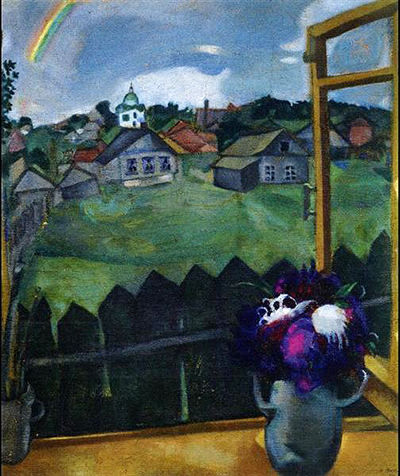Among ghostly clouds is a rainbow soaring above the town. On the windowsill is a vase with colourful flowers, giving the feeling of a spring or summer scene. An example of Naïve art and surrealism, Window Vitebsk showcases Chagall's birthplace. Born in Vitebsk in 1887, the modernist was one of the most celebrated artists in Soviet Belarus during the First World War. At the time Window Vitebsk was painted, Chagall was studying at the Zvantseva School of Drawing and Painting in Saint Petersburg. In 1910, he moved to Paris and embraced an avant-garde style. Even in Paris, the artist continued to be reminded of home and often created works based on memories of Vitebsk.
While his early work like Window Vitebsk emphasised on form, later works used colour to capture the viewer's attention. Often, his paintings created striking scenes with two or three colours. Much of his early work focused on the town where he was born and Vitebsk. Like Window Vitebsk, these paintings feel like memories and accounts of Chagall's life. They also reflect his focus on celebrating life in his artwork, and the artist often showcased life’s simplicity or hidden complexity throughout his career.
The painting is one of several Chagall created featuring views from windows, including Paris Through the Window (1913) and The Window (1924). View from a Window, Vitebsk was also created in 1908 boasts a similar view as Window Vitebsk. With bare trees and snow on the window's ledge, the painting boast more refined details. Much of Chagall's art showed places with a personal connection. He also often painted people and objects linked to his own life. Indeed, Window Vitebsk feels like the viewer is seeing Chagall's hometown through his eyes as a child. The oil on canvas measures 67 centimetres by 58 centimetres (26.4 inches by 22.8 inches). Window Vitebsk is housed in a private collection and not on display. The similar View from a Window, Vitebsk is found at the Tretyakov Gallery in Moscow, Russia.
